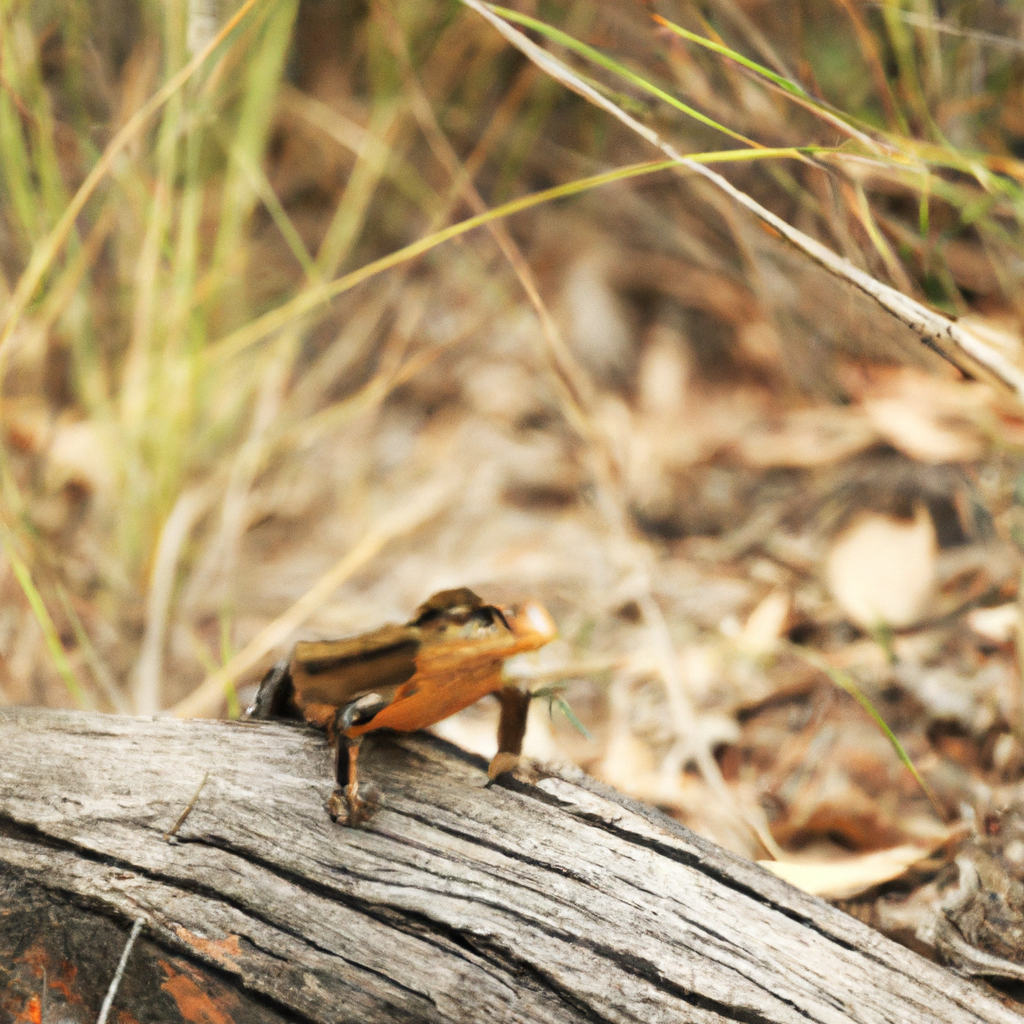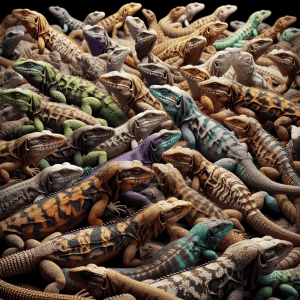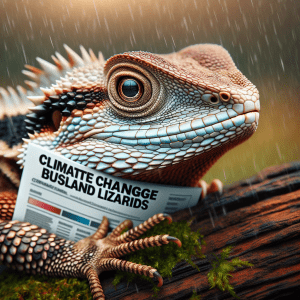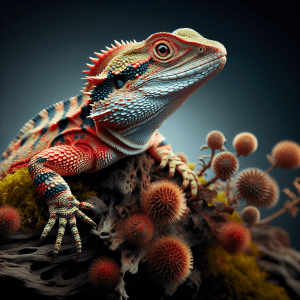Introduction
So, let’s dive into the fascinating world of lizards in the Australian bushland! I’m thrilled to share with you some of the top species that call this unique ecosystem home.
When exploring the Australian bushland, you might come across the Eastern Blue-tongue Lizard, known for its distinctive blue tongue and slow-moving nature. These lizards are quite friendly and are often seen basking in the sun or foraging for food among the leaf litter.
Another iconic species you might encounter is the Frilled Neck Lizard, famous for its impressive frill that it uses for defense and courtship displays. Imagine witnessing this lizard unfurl its frill in a dramatic fashion—it’s truly a sight to behold!
Now, let’s talk about the Thorny Devil, a master of camouflage with its spiky appearance and ability to blend seamlessly into its surroundings. Spotting one of these unique creatures in the bushland is like finding a hidden gem among the rocks and sand.
Moving on to the Shingleback Skink, also known as the “sleepy lizard” for its slow movements and docile nature. These lizards have a stumpy tail that resembles their head, a clever adaptation to confuse predators—an evolutionary marvel!
And how can we forget about the Perentie, Australia’s largest lizard species, with its impressive size and predatory prowess? Encountering a Perentie in the wild is a thrilling experience that highlights the raw beauty and power of nature.
Each of these lizard species contributes to the rich biodiversity of the Australian bushland, playing essential roles in the ecosystem. From their unique appearances to their fascinating behaviors, these lizards never cease to amaze and inspire awe in anyone lucky enough to observe them in their natural habitat.
So, next time you find yourself wandering through the Australian bushland, keep your eyes peeled for these remarkable reptilian residents—you never know what incredible encounters await you in this captivating landscape!
Importance of Lizards in the Ecosystem
Let’s dive into some interesting facts about Australian Bushland lizards. Did you know that the Thorny Devil, a unique lizard species found in the Outback, can drink water through its skin? It’s like having a built-in hydration system! These incredible creatures have adapted to survive in the arid bushland environment, showcasing the marvels of evolution at work.
Exploring the world of Australian Bushland lizards unveils a treasure trove of fascinating information. Take the Frilled Lizard, for example, known for its impressive defensive display of expanding its frill to appear larger and more intimidating. It’s like nature’s version of puffing out your chest to ward off potential threats!
Another captivating fact is the diversity of coloration among bushland lizards. From the vibrant hues of the Eastern Blue-tongue Skink to the earthy tones of the Bearded Dragon, each species has its own unique palette that blends seamlessly with the Australian landscape. It’s like a living canvas of colors roaming through the bushland.
As we marvel at these remarkable creatures, it’s essential to appreciate the role they play in maintaining the delicate balance of the ecosystem. Lizards act as both predators and prey, contributing to the biodiversity of the bushland. By understanding and protecting these species, we can ensure the preservation of this rich natural heritage for generations to come.
So, the next time you find yourself in the Australian Bushland, keep an eye out for these enchanting lizards. Their presence adds a touch of wonder to the vast expanse of the outback, reminding us of the intricate beauty of nature’s creations. Take a moment to observe, appreciate, and learn from these fascinating reptilian inhabitants of the Australian bushland.
Top Species of Lizards Found in the Australian Bushland
Picture this: you’re out on a bushwalk, the sun is shining, and you spot a lizard basking on a rock. It’s an exciting moment, right? But before you rush in for a closer look, it’s essential to ensure both your safety and the lizard’s well-being.
Here’s a practical tip for you: when approaching lizards in their natural habitat, always remember to move slowly and avoid sudden movements. Lizards can be quite skittish, and any rapid actions might startle them. By maintaining a calm and gentle approach, you not only reduce the risk of scaring the lizard away but also create a more relaxed environment for observation.
I remember once coming across a beautiful Eastern Blue-tongue lizard while hiking in the Australian bush. Instead of charging towards it, I took a few slow steps, keeping a respectful distance. To my delight, the lizard didn’t scurry off but continued its sunbathing session, allowing me to admire its intricate scales and vibrant colors up close.
By following this simple tip, you not only enhance your wildlife viewing experience but also contribute to the conservation of these magnificent creatures. Remember, our actions in their habitat can impact their behavior and overall well-being. So, next time you encounter a lizard in the Australian bushland, take a moment to appreciate their beauty from a distance and let them carry on with their lizard business undisturbed.
Encountering lizards in the wild can be a rewarding and memorable experience, and by approaching them with care and respect, we can ensure that these fascinating creatures continue to thrive in their natural environment. So, slow and steady wins the race when it comes to observing lizards in the Australian bushland!
Adaptations of Lizards to the Bushland Environment
Let’s dive into Section VIII – Interesting Facts about Australian Bushland Lizards. Did you know that some Australian bushland lizards can change color depending on their surroundings or mood? It’s like having built-in camouflage and a mood ring all in one!
I remember one time while hiking in the Australian bushland, I came across a frilled lizard that startled me with its impressive display of frills when it felt threatened. It was both fascinating and slightly intimidating to witness its defensive mechanism in action.
Speaking of defensive mechanisms, did you know that the thorny devil lizard, native to the Australian outback, has a unique adaptation to survive in the harsh desert environment? Its skin is covered in tiny spikes that help it collect and channel water towards its mouth, allowing it to stay hydrated in arid conditions.
Exploring these quirky traits and survival strategies of Australian bushland lizards really highlights the incredible diversity of nature. From the speedy blue-tongued skinks to the elusive leaf-tailed geckos, each species has its own story to tell.
Learning about these fascinating creatures not only adds excitement to your bushland adventures but also deepens your appreciation for the delicate balance of ecosystems. It’s a reminder of how interconnected all living beings are and the importance of preserving their habitats for future generations to enjoy.
So, next time you find yourself wandering through the Australian bushland, keep an eye out for these incredible lizards and marvel at the wonders of nature right at your feet. Who knows, you might stumble upon a hidden gem of the bushland, like a stumpy-tail lizard basking in the sun or a cunning sand monitor hunting for its next meal.
Nature never fails to surprise and inspire us with its infinite marvels, and Australian bushland lizards are just one small piece of the vast tapestry of life waiting to be explored.
Conservation Efforts for Australian Bushland Lizards
This part is all about the top species of lizards you can find in the Australian bushland. Picture this – you’re out exploring the vast bushland, and suddenly you spot a lizard scurrying across the dry terrain. It’s a thrilling moment, right?
Now, when it comes to identifying these fascinating creatures, a practical tip is to familiarize yourself with the key features of each species. Different types of lizards have distinct characteristics that set them apart. For instance, the Eastern Blue-tongued Lizard is known for its distinctive blue tongue and slow-moving nature, while the Frilled Neck Lizard showcases its impressive frill when threatened.
By learning about these distinguishing traits, you can easily recognize and appreciate the diversity of lizards in the Australian bushland. It’s like unlocking a hidden world right in front of your eyes!
So, next time you’re out exploring the bushland, keep an eye out for these unique features and observe how each lizard species interacts with its environment. Who knows, you might even spot a rare or elusive lizard species that adds an extra layer of excitement to your adventure.
Understanding the top species of lizards in the Australian bushland not only enhances your wildlife encounters but also deepens your connection with nature. So, grab your binoculars, put on your hiking boots, and get ready to embark on a lizard-spotting journey like no other!
Best Practices for Observing Lizards in their Natural Habitat
So, when we talk about the diverse and intriguing world of lizards in the Australian bushland, it’s impossible not to delve into the fascinating array of lizard species that call this unique habitat home. From the vibrant colors of the Eastern Bearded Dragon to the elusive Lace Monitor, the bushland is a treasure trove of lizard diversity.
Let me tell you about this one time I was hiking in the bushland, and out of nowhere, a Frilled Lizard made its appearance. With its frill extended and that distinctive stance, it was like witnessing a prehistoric creature right before my eyes. It was a moment of awe and appreciation for the wonders of nature.
Moving on to interesting facts, did you know that the Thorny Devil, a master of camouflage, can drink water through its skin? Talk about a cool party trick in the animal kingdom! These unique adaptations of Australian bushland lizards truly showcase the marvels of evolution at work.
Now, let’s discuss a practical tip for observing these creatures in their natural habitat. When you’re out exploring the bushland, remember to tread lightly and respect their space. Lizards are incredibly sensitive to disturbances, so maintaining a respectful distance and observing quietly can increase your chances of catching a glimpse of these elusive creatures in action.
The significance of preserving the habitat of these lizards cannot be overstated. As key players in the ecosystem, lizards play crucial roles in maintaining the balance of their environment. By understanding and appreciating the top species of lizards in the Australian bushland, we can work towards better conservation efforts to protect their home and ensure their survival for future generations to enjoy.
So, next time you find yourself wandering through the Australian bushland, keep an eye out for these remarkable lizard species. You never know what wonders you might encounter in this wild and untamed landscape.
Threats to Lizards in the Australian Bushland
So, let’s dive into the fascinating world of the top lizard species you can encounter in the Australian bushland. These incredible creatures have adapted to thrive in this unique environment, each with its own distinctive features and behaviors.
One standout species you might come across is the Eastern Bearded Dragon. These lizards are known for their impressive beard display, which they puff out to intimidate predators or attract mates. It’s quite a sight to witness in person!
Another iconic lizard of the Australian bushland is the Blue-tongued Skink. As the name suggests, these lizards have striking blue tongues that they use as a defense mechanism to startle potential threats. Fun fact – did you know that Blue-tongued Skinks are omnivores, feeding on a variety of insects, fruits, and even flowers?
Moving on to the Thorny Devil, a master of camouflage with its spiky exterior that helps it blend seamlessly into the bushland environment. These lizards have a unique way of collecting water through capillary action along grooves in their skin – a truly remarkable adaptation!
Now, let me share a personal anecdote related to these bushland lizards. During one of my hikes in the Australian outback, I was lucky enough to spot a Shingleback Skink sunning itself on a rock. Its slow, deliberate movements and distinctive appearance left a lasting impression on me, highlighting the beauty and diversity of the local lizard population.
As you explore the Australian bushland, keep an eye out for these incredible lizard species and appreciate the intricate balance they bring to this ecosystem. Each encounter offers a glimpse into the wonders of nature and the resilience of these remarkable creatures.
Interesting Facts about Australian Bushland Lizards
Did you know that the Australian bushland is home to some of the most unique and fascinating lizard species in the world? One interesting fact that always amazes me is the diversity of colors and patterns these lizards display. Imagine stumbling upon a vibrant blue-tongued skink or a beautifully patterned frilled lizard blending into its surroundings.
These Australian bushland lizards have evolved some incredible adaptations to thrive in their environment. For instance, the thorny devil lizard has specialized skin that helps it collect water from the morning dew in the arid outback. It’s like having your own built-in hydration system in the desert!
Another intriguing fact is the communication methods of these lizards. Some species use complex body language and color changes to signal their intentions or emotions to other lizards. It’s like a silent dance happening right in the heart of the bushland.
Now, let’s talk about the significance of these lizards in the ecosystem. These reptiles play a crucial role in controlling insect populations, maintaining the balance of the food chain, and even dispersing seeds in the bushland. Without them, the delicate ecosystem of the Australian bushland would be thrown off balance.
As we marvel at these incredible creatures, it’s essential to remember the importance of conservation efforts to protect their habitats. The bushland faces various threats, from habitat destruction to climate change, putting these unique lizards at risk. By spreading awareness and supporting conservation initiatives, we can help ensure a sustainable future for these mesmerizing reptiles.
What’s your favorite fact about Australian bushland lizards? Have you ever encountered one of these fascinating creatures in the wild? Share your experiences and let’s continue exploring the wonders of the Australian bushland together.
Tips for Encountering Lizards Safely in the Bushland
So, have you ever stopped to think about the incredible variety of lizards that call the Australian bushland home? It’s truly fascinating! One of the most mind-boggling things about these creatures is their ability to adapt to their environment over time. Did you know that some Australian bushland lizards can change color depending on their surroundings? It’s like having a built-in camouflage suit, pretty cool, right?
Let me share a little personal anecdote with you. Last summer, during a camping trip in the Australian outback, I had the most amazing encounter with a frilled lizard in the bushland. These unique creatures are known for their impressive frill that they extend when feeling threatened. It was a sight to behold, watching this lizard puff up its frill as a defense mechanism. It was a moment I’ll never forget!
Now, here’s an interesting fact for you: Australian bushland is home to the thorny devil, a small lizard with a spiky appearance that helps protect it from predators. It’s like nature’s own little tank roaming around the bushland! These lizards have a specialized diet of ants and can consume thousands in a single day. Talk about being an efficient predator!
When it comes to lizards in the Australian bushland, there’s always something new and exciting to learn. It’s not just about their physical characteristics but also the unique behaviors they exhibit in their natural habitat. From the speedy skinks darting between rocks to the majestic monitors basking in the sun, each species has its own story to tell.
Exploring the world of Australian bushland lizards opens up a whole new perspective on these fascinating creatures. It’s a reminder of the incredible diversity of life that exists in our natural ecosystems and the importance of preserving these habitats for future generations to enjoy. So, next time you find yourself in the Australian bushland, keep an eye out for these incredible lizards and appreciate the wonders of nature that surround you!
Appreciating the Diversity of Lizards in Australian Bushland
So, let’s dive into the fascinating world of lizards in the Australian bushland! Did you know that Australia is home to over 800 species of reptiles, with a significant number of those being different types of lizards? It’s truly a lizard paradise down under!
When it comes to the Australian bushland, these scaly creatures play a crucial role in maintaining the delicate balance of the ecosystem. They help control insect populations, act as prey for larger predators, and are indicators of environmental health. It’s amazing how these seemingly small creatures have such a big impact on their surroundings.
One of the top species you might encounter in the Australian bushland is the iconic Blue-tongued lizard. These slow-moving lizards are known for their distinctive blue tongues, which they use as a defense mechanism to startle potential predators. It’s quite a sight to see them basking in the sun, showing off their vibrant tongues.
Now, when you’re out exploring the bushland and hoping to catch a glimpse of these elusive creatures, it’s essential to remember to observe them from a respectful distance. Lizards, like many wild animals, can be easily scared off by human presence, so it’s best to admire them from afar and let them carry on with their lizard business.
But of course, it’s not all smooth sailing for these reptilian residents of the bushland. Threats such as habitat loss, climate change, and invasive species pose significant challenges to their survival. That’s why conservation efforts are crucial in protecting these unique and diverse lizard species for future generations to appreciate.
As you venture into the Australian bushland in search of these amazing creatures, keep your eyes peeled, stay patient, and most importantly, enjoy the beauty of nature that surrounds you. Who knows, you might just stumble upon a hidden gem of the lizard kingdom right in your backyard!




